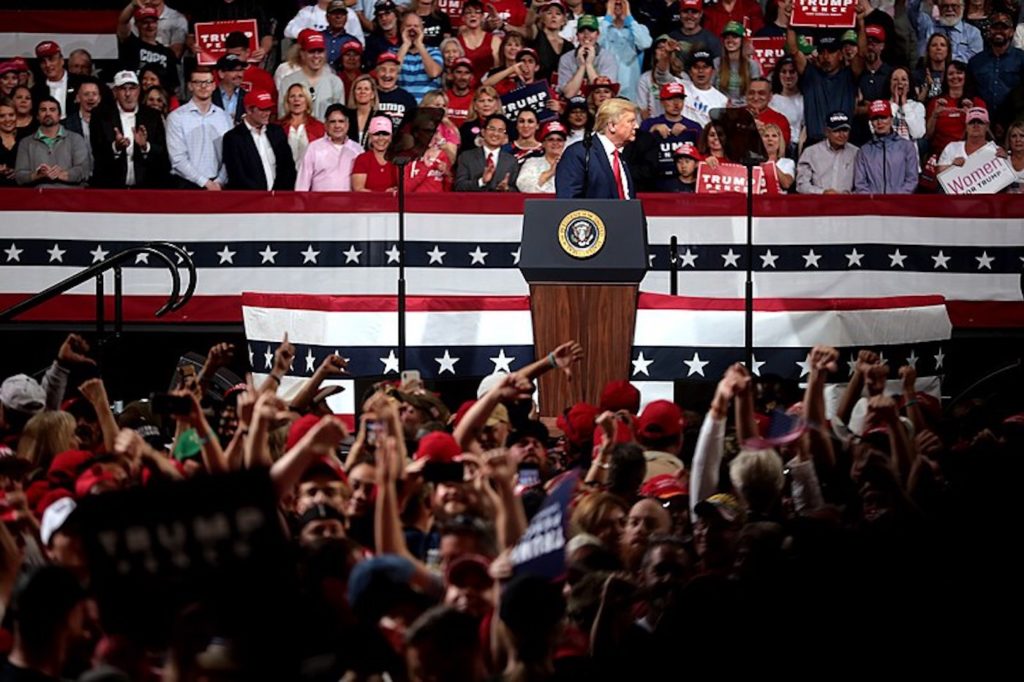Not quite thirty years ago, I sketched out a book-length history of the American political right. I had read and enjoyed George Nash’s and Jay Sigler’s tomes, but felt they were both a little dated and had excluded essential thinkers and developments. I also felt that academe, which I was in training to join, had given the political right short shrift, treating it as little more than a history of idiots, bigots, and lunatics.
I spent innumerable hours in New York University’s Bobst Library reading through old issues of National Review and The Public Interest, and plunging down assorted rabbit holes. For the better part of a year I took notes and reworked my outlines. I even floated my book idea to a grinning William F. Buckley, Jr., when I had the happy luck to be invited to lunch with the staff of National Review. No surprise, the always-up-for-action Buckley told me to go for it.
Then I abandoned the project. Various professors both right and left advised me that I was unlikely to be hired for a professorship if I wrote my dissertation on conservatism and treated it as a serious topic. I have felt lingering regret ever since.
Finally Someone Did It
Start your day with Public Discourse
Sign up and get our daily essays sent straight to your inbox.So I was thrilled when I caught wind of the recent publication of Matthew Continetti’s The Right: The Hundred-Year War for American Conservatism. Continetti is particularly well-positioned to tackle the topic. He has spent more than two decades immersed in the rightwing world. He’s the founder of the Washington Free Beacon, he has worked at the Weekly Standard and National Review, and he has published two previous books on conservative politics. He married into the Kristol family.
One of Continetti’s motivations for writing The Right was need: there simply did not exist a current, authoritative treatment of the topic. Nash’s The Conservative Intellectual Movement Since 1945 and Patrick Alliat’s The Conservatives: Ideas and Personalities Throughout American History are fine books, but they focus almost entirely on ideas. Continetti wanted to elucidate the interplay between conservative ideas and politics and policy. Good on him. “Ideas have consequences,” as Richard Weaver reminded us long ago, and more often than not conservative thought has been sparked by right-wingers’ reactions to events.
Yet, in setting that objective for the book, Continetti set himself an immense task. The interplay of conservative notions and governance goes back to the earliest days of European settlement of North America. Conservatives have written and spoken out on nearly every issue imaginable.
Instead of focusing just on ideas, Continetti wanted to elucidate the interplay between conservative ideas and politics and policy.
To make matters manageable, he limits the book’s scope to “the [American] writers who set in motion the interplay of ideas and institutions of ideology and politics.” So, one will not find discussions of influential European thinkers, like the British philosopher Michael Oakeshott. Nor does the book dwell on the polemicists who deal more in insults than ideas. Westbrook Pegler, the belligerent columnist who called Franklin D. Roosevelt “moosejaw,” gets brief mention; so too modern-day bomb-throwers Laura Ingraham and Ann Coulter. The book also excludes coverage of the “corporations, big donors, and dark money” that have fueled rightwing politics. And as the book’s subtitle indicates, Continetti also limits his coverage to the past century.
Even so, The Right runs a little over 400 pages not counting the forty-four pages of endnotes. Yet the book reads quickly, thanks to Continetti’s graceful writing. Its coverage of thinkers well known (Friedrich Hayek and George Will), little remembered (Irving Babbitt and Albert J. Nock), and somewhere in between (James Burnham and Martin Diamond) is compendious. Critically, readers will see how their ideas ebbed and flowed into America’s domestic and foreign policies. With any luck, the book will spur more Americans to rediscover conservatism’s myriad family tree branches.
And those readers who are trying to make sense of the current state of conservatism and its future will concur with William Faulkner’s insight that “the past is never dead. It’s not even past.”
What is Old is New Again
Continetti’s telling of conservative history illustrates that it has at least five enduring features.
First, conservatism by its nature mostly looks backward, and draws on the past to face the challenges of today. Continetti illustrates this particularly well by showing the parallels between the GOP administrations of the 1920s (Harding and Coolidge particularly) and the single-term presidency of Donald Trump. They had in common full-throated Americanism, curbs on immigration, a retreat from foreign entanglements, and economic liberty. For the right, what is old often becomes new again. Today’s integralists sound much like L. Brent Bozell in the late 1960s.
Second, the right has always been cacophonous, with its members frequently arguing with one another as vociferously as they argued with the left. The taxonomy includes libertarians, traditionalists, majoritarians, agrarians, anticommunists, Straussians (West Coast and East Coast), fusionists, paleoconservatives, neoconservatives, New Rightists, religious fundamentalists, and more. The diversity of thought on the right flows from the various aspects of the American tradition that different thinkers find important and most worth conserving. For some, it is liberty, while for others it is local community and particular ways of life or moral values. The same holds true with what each group on the right considers the biggest threat: for some it is secularism, for others it may be materialism, vice, crime, bureaucracy, globalism, or malevolent foreign governments.
Which leads to a third big truth about the right: only rarely do the various tribes of the right come together to govern at the federal level. Their unity, Continetti points out, necessitates finding a common peril. For example, communism and the existential Soviet threat glued the factions together for decades. After the Berlin Wall fell, the unwinding began. Karl Rove and others thought the atrocities of 9/11 and the global war on terrorism might fashion a “durable majority” of hawks, neoconservatives, and the religious right. It didn’t, and provoked a populist backlash.
And the feuds between populism and elite conservatism, which vary in amplitude over time, are a fourth feature of American conservative history. They are constant, with one or more factions insisting that the right-wingers who hold government positions or the thinkers who have their ear are sell-outs. The recent gripes about “Conservatism, Inc.” and “cuckservatives” are just the latest variation. Why this occurs is not entirely clear, although it probably flows from the tensions between ideological purity and the practicalities of governance. It is easy, for example, to demand government get spending under control. It is far more challenging to tell tens of millions of Americans that you are going to try to cut their entitlement checks.
The feuds between populism and elite conservatism are constant, with one or more factions insisting that the right-wingers who hold government positions are sell-outs.
Last, and least pleasantly, The Right cautions us that cranks and nativists will be with us always. During the past decade, there has been plenty of nuttiness. Some on the right accused Barack Obama of being a Manchurian candidate seeking to wreck America out of post-colonial rage, while QAnon “patriots” propagate gibberish about pedophilia cabals and mass executions of liberal traitors. All of which is lamentable, but not entirely novel. In the 1990s, rightwing fantasists accused former President Bill Clinton of murder and drug smuggling, among other crimes. During the 1960s, the John Birch Society leadership railed against secret conspiracies among high government officials and claimed Dwight Eisenhower was a pinko. Thirty years earlier, Father Coughlin used his widely heard radio program to advocate proto-fascism. Flakes are a bane to the political right, sowing needless division among conservatives and blighting the movement.
Reviving Conservatism
Continetti closes his book with a call for the right to tamp down its dissonance and “forge a new consensus, based on the particularly American idea of individual liberty exercised within a constitutional order, that addresses the challenges of our time.” He warns the right that the future does not lie in relentless rabble-rousing or in trying to swap Old World post- and anti-liberal philosophies onto American root stock. In his view, the rediscovery of America
must center on America’s founding documents, for there would be no American conservatism without the American founding . . . The Constitution grounds conservatives in a uniquely American tradition of political thought that balances individual rights and popular sovereignty through the separation of powers and federalism . . . The preservation of the American idea of liberty and the familial, communal, religious, and political institutions that incarnate it and sustain it—that is what makes American conservatism distinctly American. The right betrays itself when it forgets this truth. Why? Because the job of a conservative is to remember.
Certainly, the odds of the right’s finding more harmony would increase if it could ground its thinking about American governance in its ingenious charters of freedom. And doing this would be music to the ears of many conservatives, who hold sacred the Founding.
Yet, my own long view of the history of the right suggests this alone will not be enough. Once office is won the victors must govern, and do so without finding themselves besieged for “selling out” by their fellow populist conservatives. Principles and ideas are critical, but issue-area expertise is needed as is political aretē—that excellence in political persuasion needed to build majorities to get policy enacted. Too few conservative activists have undertaken advanced studies in public policy. Too few conservative thinkers have spent any time working in government with non-conservatives to hammer out agreements they both can live with. And conservative wonks and thinkers, for their part, should get out of their power circles more often and better ground themselves in the concerns and language of regular Americans.
At times, America has had moments when this gap has been bridged. During his two terms, Reagan staffed his administration with deeply competent individuals committed to conservative ends. He listened to them, but he also paid close attention to the views of voters. Conservative policy and principles were united, and the country prospered. And isn’t that what everyone on the right wants?













